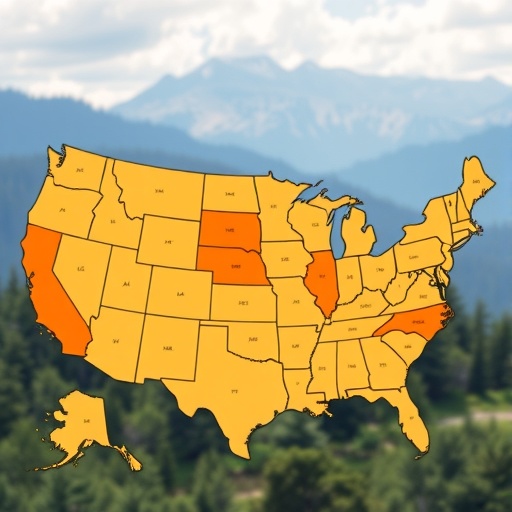In an illuminating new study published in PLOS One, researchers from Canada and the United States reveal how centuries-old settlement patterns continue to shape the physical, social, and existential wellbeing of Americans today. By analyzing survey data from over 325,000 residents across the United States, David R. Samson of the University of Toronto and colleagues uncover what they term the “First Settler Wellness Effect,” demonstrating a profound cultural legacy that influences regional differences in wellness metrics.
This groundbreaking research builds on Colin Woodard’s American Nations Model, a framework that partitions North America into distinct cultural regions shaped by early colonial settlement histories. The model identifies eleven rival cultural nations within the continent, each bearing unique collective identities forged by the social norms, economic systems, and ideological forces introduced by their first settlers more than two centuries ago. Samson and his team sought to test whether the cultural legacies embedded in these historic settlement patterns exert measurable impact on contemporary wellbeing across the United States.
Wellbeing, as the study defines it, is conceptually bifurcated into ‘traditional’ and ‘existential’ components. Traditional wellness encompasses tangible aspects such as physical health, financial security, and social support networks—factors often linked to infrastructure and economic stability. Existential wellness, in contrast, taps into more intangible dimensions like a person’s sense of purpose, community belonging, and personal autonomy. By disentangling these domains, researchers could map how different parts of the country exhibit varying strengths in distinct wellness types.
Employing data collected through the Gallup-Healthways Well-Being Index from 2009 to 2016, which compiled responses from 325,777 individuals, the study offers a comprehensive and rigorously controlled examination of regional wellbeing trends. The spatial distribution of traditional versus existential wellness aligns strikingly well with the cultural territories delineated by Woodard’s model. For example, Northeastern and Midwestern states manifest notably higher scores in traditional wellness indicators. This predilection is likely rooted in the regions’ long-standing health systems, widespread social services, and stable economies—remnants of the industrious, community-oriented settlers who initially colonized the area.
Conversely, Southern states, shaped by different colonial origins that emphasized honor-based social codes, personal autonomy, and kinship networks, tend to excel in existential wellness measures. The Southern cultural emphasis on loyalty and social reputation cultivates a unique sense of identity and purpose, compensating for relatively lower traditional wellness metrics. This contrast eloquently illustrates how deeply embedded cultural values can influence subjective wellbeing independently of material conditions.
The findings become even more nuanced when dissecting data along racial and ethnic lines within these regions. Black and Hispanic populations show patterns mirroring general regional trends: they report higher traditional wellness in the Northeast and Midwest and heightened existential wellness in Southern states. However, disparities emerge when compared with White populations. Black residents, for example, consistently experience lower traditional wellness across all regions, particularly suffering additional existential wellness deficits in the Northeast and Midwest. These inequities highlight systemic barriers and limitations in access to resources and opportunities, underscoring the intricate interplay between cultural legacies and structural inequalities.
Samson and colleagues suggest that robust community support present in Southern regions may buffer some of the economic and health disparities faced by minority populations, reflecting a potent cultural mechanism that mitigates vulnerability. This observation provokes important questions regarding the social determinants of health and the potential for culturally informed interventions to enhance wellbeing in various demographic groups.
From a methodological standpoint, the study’s integration of spatial cultural divisions with large-scale survey data represents a sophisticated empirical approach rarely attempted at this scale. The use of the American Nations Model transcends conventional state-bound analyses, providing a culturally nuanced lens that captures lived experiences more authentically. By controlling for socioeconomic variables, the researchers affirm that the observed wellbeing differences are not mere artifacts of wealth or education but deeply intertwined with the enduring imprint of settler cultures.
The study’s implications are multifaceted and reach beyond academic interest. Public health policies and mental health initiatives, for instance, could be tailored to align better with regional cultural ecologies to optimize effectiveness. Recognizing the distinct wellness profiles rooted in community history and cultural values could drive more targeted, empathetic, and sustainable strategies to improve overall quality of life.
Furthermore, this research accentuates the tenacity of culture as a factor shaping human experience across centuries. The authors remark on the “durability of culture,” emphasizing that ancient patterns of settlement—not just contemporary economic metrics—cast long shadows on present-day social and psychological wellbeing. Yet, this cultural influence is not destiny but rather a critical context within which adaptive policies can operate.
Looking ahead, the study paves the way for future research to identify the precise mechanisms through which settler cultural legacies persist in influencing health and wellbeing. Questions arise regarding the role of local institutions, social norms, and policy environments in either reinforcing or mitigating these effects. Exploring these pathways could yield invaluable insights for addressing health disparities and fostering community resilience.
In conclusion, Samson and collaborators’ investigation into the First Settler Wellness Effect offers a novel and compelling framework for understanding American regional wellbeing disparities. By bridging historical settlement patterns with modern survey data, the study opens a new interdisciplinary frontier linking anthropology, psychology, and public health. The recognition that centuries-old cultural partitions maintain a dynamic role in shaping how individuals feel and thrive invites a deeper reconsideration of how history informs our present and future.
Subject of Research: Not applicable
Article Title: Wellbeing across the American Nations: First Settler Effects influence traditional and existential wellness
News Publication Date: 10-Sep-2025
Web References: http://dx.doi.org/10.1371/journal.pone.0327972
References: Samson DR, Oesch N, Woodard C (2025) Wellbeing across the American Nations: First Settler Effects influence traditional and existential wellness. PLoS One 20(9): e0327972.
Image Credits: Samson et al., 2025, PLOS One, CC-BY 4.0
Keywords: Wellbeing, American Nations Model, First Settler Wellness Effect, traditional wellness, existential wellness, regional culture, settlement patterns, health disparities, cultural legacies, public health policy




